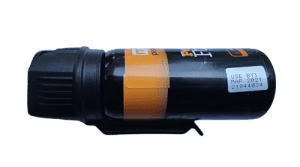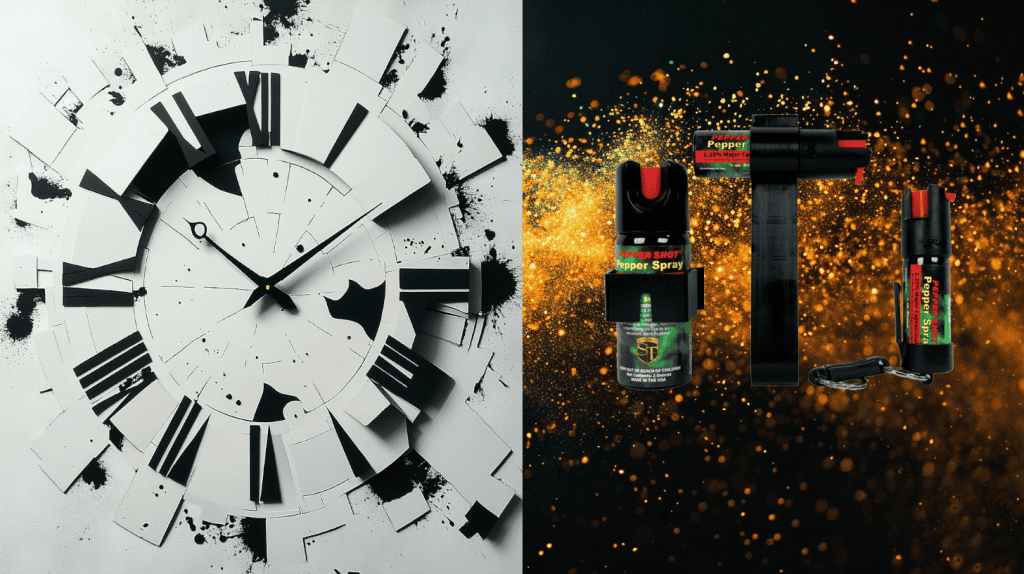Yes, pepper spray does expire, usually after three to four years. Over time, the active ingredients like oleoresin capsicum and the propellant degrade, reducing the spray’s effectiveness. In the first year, it maintains high stability, but its potency and range markedly decline after three to four years. Always check the expiration date on the canister, typically found on the bottom or side. Using expired pepper spray can be dangerous, as it may fail or only partially incapacitate an attacker. For peak safety, store it in cool, dry conditions and test it regularly. Staying informed guarantees continued protection.
Key Takeaways
- Pepper spray typically expires in three to four years.
- Expired pepper spray has reduced effectiveness and may compromise safety.
- Check for expiration dates on the bottom or side of the canister.
- Expired spray can have a weakened range and sputtering nozzle.
Understanding Pepper Spray Composition
 Pepper spray mainly comprises oleoresin capsicum, a natural oil derived from hot peppers. This key ingredient is responsible for your intense burning sensation when exposed. Oleoresin capsicum contains capsaicinoids, which are the active compounds that cause irritation.
Pepper spray mainly comprises oleoresin capsicum, a natural oil derived from hot peppers. This key ingredient is responsible for your intense burning sensation when exposed. Oleoresin capsicum contains capsaicinoids, which are the active compounds that cause irritation.
Other pepper spray ingredients include a propellant, which helps disperse the spray, and a solvent, which keeps the solution stable. Water, ethanol, or other alcohol-based solutions often serve as solvents.
When you use pepper spray, a chemical reaction occurs between these ingredients and the air, releasing capsaicinoids in a fine mist. This mist can effectively incapacitate an attacker by causing temporary blindness, difficulty breathing, and a severe burning sensation on the skin.
Understanding the chemical reactions involved helps you appreciate why pepper spray is so effective. The interaction between oleoresin capsicum and your mucous membranes triggers an immediate inflammatory response. The capsaicinoids bind to pain receptors, causing intense discomfort.
This quick reaction makes pepper spray a reliable self-defense tool. However, its effectiveness depends on the concentration and quality of the ingredients, which can degrade over time, affecting the spray’s potency.
Shelf Life of Pepper Spray
Like many other products, pepper spray has a shelf life that you need to be aware of to guarantee its effectiveness. Over time, the active ingredients in pepper spray can undergo chemical degradation, reducing its potency. Typically, pepper spray has a shelf stability ranging from three to four years. Beyond this period, the chemicals may break down, resulting in diminished efficacy.
Here’s a helpful table to illustrate the shelf life of pepper spray:
| Time Period | Shelf Stability | Effectiveness |
|---|---|---|
| 0-1 Year | High | Ideal |
| 1-3 Years | Moderate | Good |
| 3-4+ Years | Low | Reduced |
During the first year, pepper spray maintains ideal effectiveness due to its high shelf stability. As it approaches the three-year mark, you might notice a moderate decline in potency. After four years, the spray’s chemical stability greatly decreases, leading to a notable reduction in effectiveness.
To ensure the reliability of your pepper spray, monitor its age and replace it as needed. This proactive approach helps maintain your safety and guarantees the spray performs as intended when needed.
Finding the Expiration Date
 To find the expiration date on your pepper spray, check the label or packaging for a clearly marked date. Most manufacturers include this information on the product itself or on the accompanying product packaging. Look for phrases such as “best by,” “expiration,” or simply a date stamp. The expiration labeling is typically found on the bottom of the canister or along the side, making it easy to locate.
To find the expiration date on your pepper spray, check the label or packaging for a clearly marked date. Most manufacturers include this information on the product itself or on the accompanying product packaging. Look for phrases such as “best by,” “expiration,” or simply a date stamp. The expiration labeling is typically found on the bottom of the canister or along the side, making it easy to locate.
Pepper spray manufacturers must provide clear expiration labeling due to the safety implications of using outdated products. Over time, the active ingredients in pepper spray can degrade, reducing its effectiveness. To guarantee your safety, you must know the expiration date and replace the product as needed.
If the product packaging is unavailable, consult the manufacturer’s website or customer service for guidance. Some brands may also include many numbers that you can reference for information on the manufacturing and expiration dates.
Keeping your pepper spray up to date guarantees it functions properly when you need it most, providing you with reliable self-defense. Always prioritize checking the expiration date to maintain the product’s integrity.
Signs of Expired Pepper Spray
Over time, you’ll notice that expired pepper spray may have a weakened spray pattern or a reduced range. These are some of the clearest expired spray indicators. When pepper spray degrades, its effectiveness diminishes, leading to a less reliable defense tool.
One of the first signs of pepper spray degradation is a sputtering nozzle. Instead of a steady stream, the spray may come out in bursts, compromising its ability to reach a target effectively. This can be due to the propellant losing its potency over time.
Another indicator is a change in the spray’s range. Fresh pepper spray typically ranges 8-12 feet, but expired spray might only reach a few feet, putting you at risk. Additionally, the potency of the capsaicinoids—the active ingredients in pepper spray—can degrade, leading to a less intense reaction from the target.
Moreover, a visual inspection of the canister can reveal signs of wear or rust, which may affect the internal components and sealing. Expired pepper spray might also have a different odor, hinting at chemical changes inside the canister.
Risks of Using Expired Spray
Using expired pepper spray poses several risks, including reduced spray effectiveness, which can compromise your safety in an emergency. The expired spray may also leak or malfunction, leading to potential safety hazards for the user and others nearby.
Reduced Spray Effectiveness
 Relying on expired pepper spray can compromise its potency, leaving you vulnerable in critical situations. As pepper spray ages, its active ingredients degrade, reducing its effectiveness. When you face an attacker, an expired canister mightn’t deliver the incapacitating impact you expect. This diminished potency can render your self-defense tool practically useless.
Relying on expired pepper spray can compromise its potency, leaving you vulnerable in critical situations. As pepper spray ages, its active ingredients degrade, reducing its effectiveness. When you face an attacker, an expired canister mightn’t deliver the incapacitating impact you expect. This diminished potency can render your self-defense tool practically useless.
An impact assessment of expired vs. non-expired pepper spray shows a considerable drop in irritation and disorientation effects.
Using expired pepper spray introduces unpredictable variables. The spray pattern might become inconsistent, affecting coverage and accuracy. Additionally, the pressure inside the canister can decrease over time, shortening the spray distance and reducing your ability to maintain a safe space from a threat.
Data from various studies indicate that the capsaicinoid concentration—the chemical responsible for the burning sensation—can drop considerably after the expiration date. This reduction means that the effect won’t be as debilitating even if you hit your target.
Regularly checking and replacing your pepper spray guarantees you have a reliable defense tool. Don’t wait until you’re in a dangerous situation to find out your pepper spray has lost its effectiveness. Stay proactive and prioritize your safety.
Potential Safety Hazards
Ignoring the expiration date on your pepper spray can expose you to several safety hazards. First, an expired spray mightn’t deploy effectively, leaving you vulnerable in vital situations. Any malfunction can compromise your safety when you count on it for self-defense.
Taking proper safety precautions involves understanding the risks associated with expired pepper spray. Here are three potential hazards:
- Reduced Pressure: Over time, the propellant in the canister can degrade, resulting in a weak or inconsistent spray that won’t reach your target.
- Clogged Nozzle: Components in an expired spray can solidify, causing blockages that prevent the spray from discharging when you need it most.
- Chemical Breakdown: The active ingredients may lose potency, making the spray less effective at incapacitating an attacker.
It is important to incorporate these risks into your emergency preparedness plan. Regularly checking expiration dates and replacing outdated canisters guarantees that you’re always ready to defend yourself effectively.
Studies have shown that the reliability of safety equipment decreases considerably past its expiration date, making it vital to stay vigilant. Don’t let an expired pepper spray be the weak link in your safety strategy.
Legal Implications
Besides the safety hazards, expired pepper spray can also lead to legal complications if used in a self-defense situation. Legal regulations surrounding the use of pepper spray vary by jurisdiction, and utilizing an expired product can introduce unforeseen liability issues. Expired sprays may not function as intended, causing you to rely on a defective product in vital moments. This can be interpreted as negligence, complicating your legal defense.
Consider the following emotional table highlighting potential outcomes:
| Scenario | Outcome | Emotion |
|---|---|---|
| Pepper spray fails during an attack | Increased risk of harm | Fear |
| Legal scrutiny over expired spray | Potential legal penalties | Anxiety |
| Effective self-defense with fresh spray | Successful deterrence | Relief |
The inconsistency of expired sprays can also lead to questions about your judgment and the appropriateness of your actions. Law enforcement and legal authorities may scrutinize whether you exercised reasonable care in maintaining your self-defense tools. If your spray fails, you could face both increased personal danger and legal consequences for using substandard equipment.
Keeping your pepper spray up-to-date guarantees compliance with legal regulations and reduces liability issues, giving you peace of mind in self-defense. Regularly checking and replacing your pepper spray is a small but essential step in protecting yourself physically and legally.
How to Properly Store Pepper Spray
To guarantee its effectiveness, store your pepper spray in ideal conditions away from extreme temperatures. Aim to keep it in a cool, dry place, as high heat can cause the canister to burst while freezing temperatures might reduce its potency. Always check the manufacturer’s guidelines for specific storage recommendations to maintain its reliability.
Optimal Storage Conditions
Proper storage of pepper spray guarantees its effectiveness and longevity. To ensure your pepper spray works when needed, follow these guidelines for ideal storage conditions.
First, control humidity. Excess moisture can corrode the canister and affect the spray’s potency. Aim to store the pepper spray in a dry environment with minimal humidity. Utilize silica gel packets or dehumidifiers if necessary.
Second, minimize light exposure. Direct sunlight or artificial light can degrade the chemical composition of the spray, rendering it less effective. Store your pepper spray in a dark place, such as a drawer or cabinet, to protect it from light.
Third, consider these additional tips:
- Original Packaging: Keep the pepper spray in its original packaging to provide an extra layer of protection against environmental factors.
- Accessibility: Store it in a location that’s easily accessible in emergencies but out of reach of children and pets.
- Regular Checks: Periodically inspect the canister for any signs of damage or leakage.
Avoid Extreme Temperatures
In addition to controlling humidity and light, you must also avoid exposing your pepper spray to extreme temperatures to maintain its effectiveness. Temperature extremes can drastically affect the potency and functionality of the spray. Ideally, keep your pepper spray between 50°F and 70°F. High temperatures can cause the pressure inside the canister to increase, potentially leading to leaks or even ruptures. Conversely, low temperatures can reduce the pressure, making the spray less effective when needed.
When selecting storage locations, choose a place that consistently maintains a moderate temperature. Avoid leaving your pepper spray in a car, as vehicles can experience significant temperature fluctuations. A glove compartment in summer can become dangerously hot, while it might get too cold in winter.
Instead, consider storing it in a drawer at home or carrying it in a purse or bag if you need it on the go. Also, avoid placing it near heat sources like radiators or windows exposed to direct sunlight.
Testing Your Pepper Spray
 Regular testing confirms that your pepper spray is still effective and ready for use. To guarantee that your pepper spray functions correctly, you must follow some systematic testing methods. This process involves evaluating its effectiveness by examining several key factors.
Regular testing confirms that your pepper spray is still effective and ready for use. To guarantee that your pepper spray functions correctly, you must follow some systematic testing methods. This process involves evaluating its effectiveness by examining several key factors.
First, check the spray pattern by lightly pressing the trigger outdoors, away from people and animals. This helps you confirm that it sprays a consistent and focused stream or mist.
Here’s a simple three-step method:
- Check the Spray Pattern: Lightly press the trigger to see if it produces a consistent stream or mist.
- Evaluate the Pressure: Notice if there’s sufficient pressure when spraying. A weak spray indicates diminished propellant.
- Inspect for Leaks: Look at the canister for any signs of leakage, which could compromise its effectiveness.
Monitoring these aspects guarantees that your pepper spray will work when needed.
Regular effectiveness evaluation is essential, as the propellant can degrade over time, and the spray mechanism might become less reliable.
Additionally, remember to test in a safe and controlled environment to avoid accidental exposure.
Replacing Expired Pepper Spray
When your pepper spray expires, it must be replaced promptly to guarantee your safety. Over time, the active ingredients in pepper spray can degrade, reducing its effectiveness. Using expired spray during a significant situation may fail to protect you adequately.
To dispose of expired spray, follow local hazardous waste disposal guidelines. Many communities have designated drop-off points for items like pepper spray. Proper expired spray disposal prevents environmental contamination and ensures that the chemicals don’t end up in the wrong hands.
Recycling pepper spray is another responsible option. Some manufacturers and recycling centers offer programs to handle used or expired cans. Contact the manufacturer for specific instructions on pepper spray recycling. They may have a mail-back program or suggest nearby recycling facilities equipped to deal with hazardous materials.
Always purchase a new can from a reputable supplier to ensure you get a product with a long shelf life. Check the expiration date upon purchase and mark your calendar for a reminder to replace it before it expires. Staying vigilant about the efficacy of your defensive tools is vital for your personal safety.
Alternatives to Pepper Spray
If you’re looking for other self-defense options, several alternatives to pepper spray can provide effective protection. Understanding these personal safety alternatives can help you choose the best self-defense tools for your needs.
- Stun Guns: Stun guns deliver an electric shock that temporarily incapacitates an attacker. They’re compact, easy to carry, and provide a non-lethal means of protection. Research shows that stun guns can be effective in deterring assailants, offering you precious time to escape.
- Personal Alarms: When activated, these devices emit a loud, piercing sound, drawing attention and potentially scaring off attackers. Studies indicate that personal alarms can be particularly effective in crowded areas where bystanders can intervene. They’re also lightweight and easy to conceal in a purse or pocket.
- Tactical Flashlights: Tactical flashlights illuminate dark areas and can also be used as striking tools. Many models include features such as strobe modes to disorient attackers. According to security experts, the combination of light and force makes tactical flashlights a versatile self-defense tool.
Each of these alternatives provides unique benefits, so consider your environment and personal preferences when selecting the right self-defense tool for you.


